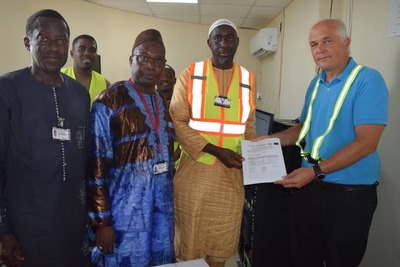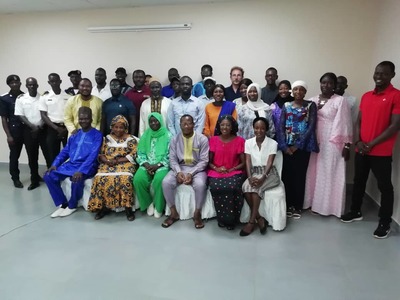Fisheries Department Units;
The Department is responsible for the management, development and conservation of fisheries resources in The Gambia. There are six units namely;
- Directorate and Administration
- Monitoring, Control and Surveillance (MCS)
- Aquaculture and Inland Fisheries
- Extension
- Fisheries Research and Development
- Inspectorate
The Fisheries Department’s mandate is the;
- Conservation and the assessment of fish stocks;
- Collection of statistics on fisheries and aquaculture;
- Management and development of fisheries and aquaculture;
- Preparation and periodic review of fishery management and development plans in accordance with the Act;
- Issuance, suspension and cancellation of licenses or other authorizations for fishing and any other activities for which licenses or authorizations are required under the Act;
- Collection of fees paid in respect of fishing licenses;
- Monitoring, control and surveillance of fishing operations;
- Promotion of the establishment of Community Fisheries Centres, fisherfolks cooperatives and associations and other bodies representing fisherfolks, fish processors or aquaculture producers;
- Promotion of scientific research and the development of appropriate technologies in support of the conservation and management of fisheries and aquaculture;
- Promotion of the development of artisanal fisheries and of a locally based industrial fishing industry through the provision of extension and training services and credit and infrastructure facilities; and
- Development of domestic and foreign markets for fish and fishery products.
The Fisheries Department is the technical arm charged with the responsibility to conduct research, resource conservation, management and development, capacity development, extension services to fishing communities and technical cooperation. The overall objective of the sector is the conservation, management and development, taking into account food security and poverty reduction as enshrined in national development blueprints.
Evolution of Fisheries Policy in The Gambia
The development of fisheries policy documentation in The Gambia could be traced from the semblance of policy statements made at the time of the establishment of the Department of Fisheries in the 1960s culminating over more than half a century in this Fisheries and Aquaculture Policy of the Gambia of 2018.
The Fisheries Policy in National Development Plans/Development Programmes
Successive national development plans over the course of 10 years (1975-1980 & 1980-1985) defined fisheries policy objectives for directing intercessions in the fisheries sector which were subjected to review as part of the Economic Recovery Programmes (ERP), 1985−1989 and the succeeding Programme for Sustained Development (PSD) of the 1990’s. Despite the lack of verifiable actions developed to achieve the stated objectives, the following indicated “to do/s” could be summarised below:-
- to improve the institutional capacity for the management of the fisheries sector
- to improve the legal framework governing the fisheries sector
- to regulate industrial fishing with a view to making output consistent with a rational and sustainable approach to production
- to develop and expand small scale fishing and increase Gambian, especially female, participation in the sector
- to develop aquaculture
- to improve the economic environment surrounding the fisheries sector with a view to enhancing the sector’s contribution to the national economy.
The so-called objectives neither had any linkage to an overarching goal wherein, the objectives could now become concrete steps towards the desired state of affairs nor were follow-up strategic actions developed and implemented in a coordinated manner.
The Fisheries Policy Revision of 1994
It is therefore not surprising that once the potential of the fisheries sector to make significant contribution to societal wellbeing became more apparent, the aforementioned policy objectives were subjected to revision in 1994 during the process of developing The Gambia Fisheries Strategic Plan 1994-2004. The Strategic Plan followed recommended prudent management, rational and sustainable production methods and efficient utilization of existing fish stocks. The revised national policy objectives for the development of the fisheries sector were as follows:
- to promote the rational and long-term utilization of fisheries resources
- to improve the nutritional standards of the population;
- to increase employment opportunities in the sector;
- to increase the net foreign exchange earnings from fisheries;
- to expand Gambian participation in the sector;
The Fisheries Policy 2007
The Fisheries Policy of 2007 is regarded as the first detailed policy document that went through a wide range of consultation that prescribed the following policy objectives gaining official Government adoption:
- to effect a rational and long-term utilization of the marine and inland fisheries resources;
- to use fish as a means of improving nutritional standards of the population;
- to increase employment opportunities in the sector;
- to increase the net foreign exchange earnings;
- to increase and expand the participation of Gambians in the fisheries sector ;
- to develop aquaculture;
- to improve institutional linkages with other relevant sectors;
- to improve the institutional capacity and legal framework for the management of the fisheries sector;
To be recognized as one of three most critical contributors to national economic growth, food and nutrition security, employment creation and exchange earnings.
Through the recognition of fisheries and aquaculture potentials as natural economic resources and by ensuring responsible and ecologically sustained fishing and aquaculture practices, to optimally harness The Gambia’s fisheries and aquaculture resources and to deliver employment, foreign exchange support, food and nutrition security in achieving accelerated national growth and development.


